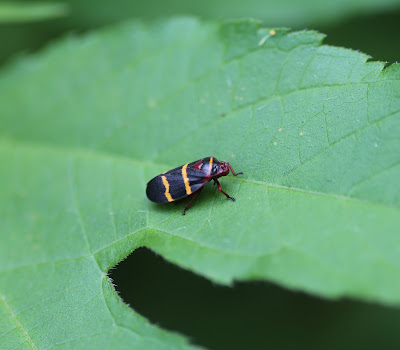Spittlebugs are the nymphs of froghoppers, and there seems to be some debate as to whether that is because they can jump 100x their body length! Or if the name came to be because their head superficially resembles a frog head. They are a common sight all over Missouri, the spit balls they leave behind are easily spotted and for those that have no idea what they are they can be a bit perplexing. Inside that foamy spit-like substance is the nymph of the froghopper. It is this foamy matter that earned them their common name. the foamy spittle goes by various names including frog spit, cuckoo spit, and snake spit.
Many insects feed on the sap of plants or trees, usually these insect are seeking the rich, nutrient packed sap. In the case of the spittlebug, it does something remarkable. It feeds on the nutrient poor diluted sap, made up mostly of water. This thinner water-sap is headed to the roots, and spittlebugs intercept it for a meal. They produce symbiotic bacteria, that allows them to receive the nutrients, such as important amino acids. This watery diet would most like kill any other bug for lack of important nutrients. Because of this watery diet they also produce copious amount of urine, as much 280x their body worth of urine! This would be like a human voiding 2700 gallons of urine each day! Because the spittle evaporates faster than water, it explains why they must produce so much of it each day.
The foam is produced using the excreted urine emitted from their backside, that combines with a sticky substance that helps adhere it to plants. The foam not only hides them from potential predators and parasites, which is said to taste acrid and distasteful to would-be predators. Not that I would want to taste it and see if they are right! The foam also protects them from weather fluctuations, by insulating them from cold and heat. This thermal control as well as the moisture control, keeps the insect from drying out, which would a certain death sentence. They are capable of producing a yellow blood-like substance from their legs, that it thought to taste bad to predators.In scientific studies done in Berlin, Germany scientists were trying to understand the prey response to the foam. Using ants as their predator of choice, they discovered that when the foam was placed in a dish the ant would sip from it as if gleaning moisture from it. But when placed on the foam they struggle vigorously to free themselves, exhibiting the adhering capabilities of the foam. So how does the foam not cause the same problems for the nymph living inside? Apparently much like the spider navigates its own web without sticking to it, the spittlebug possess the same amazing ability. Breathing within the little foam shelter is done with the use of special breathing apparatuses on their abdomen. The foamy bubbles are filled with oxygen, and occasionally the nymph may pierce a bubble to extract oxygen.
Adults are capable of jumping as much as 28 inches vertically from plant to plant. This high jumpcapability would explain the name froghopper. This acrobatic feat is a more impressive performance relative to body size than the flea! In northwest Missouri the most common froghopper is the two-lined spittlebug. The adults are black with two reddish colored lines. Like the nymphs living in the spittle, the adults also feed on plant tissue. They usually don’t occur in large enough numbers to cause any significant damage to plants. Occasionally there may be population explosions, and during those outbreaks they can cause damage to turf grass and various plants. If their feeding is causing harm you may have to resort to insecticides for control.A few weeks ago, my granddaughter and I were driving around the fields when she asked me what those white things were on the plants, and by white things she was referring to the foamy substance produced by the spittlebug. I told her that an insect lived inside, but she looked rather dubiously at me, most likely thinking I am crazy. I opened one to show her, and she pronounced it cute. In a yellow-green, wet, alien-looking way I guess they are. Nature discoveries can be found in surprising places and there is no better way to explore than with a child. This shared exploration will take you back to your own childhood, and bring back the memories of the discoveries you made all those years ago.








